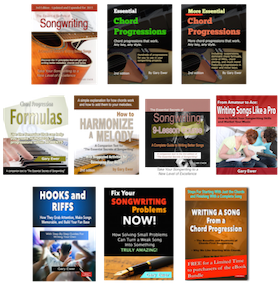Five suggestions for verse and chorus progressions that work well together.
____________
“The Essential Secrets of Songwriting” 10-eBook Deluxe Bundle includes: “From Amateur to Ace: Writing Songs Like a Pro”. Right now, the Deluxe Bundle comes with a special deal. READ MORE..
_____________
 It’s completely fine to write a song that uses the same chords for both the verse and the chorus, as you’ll find, for example, in the song “Lights”, by Ellie Goulding: G#m F# E C#m. Using the same progression works particularly well if the verse and chorus melodic shapes are very dissimilar.
It’s completely fine to write a song that uses the same chords for both the verse and the chorus, as you’ll find, for example, in the song “Lights”, by Ellie Goulding: G#m F# E C#m. Using the same progression works particularly well if the verse and chorus melodic shapes are very dissimilar.
Using different progressions for the verse and chorus is relatively common in songwriting. A song can use four or even more progressions: one each for the verse and chorus, and then usually additional ones for other optional sections such as pre-chorus and bridge.
Even though the various progressions differ from each other, it’s best if they are related somehow. Like members of a family, it’s common to notice similarities between a song’s different progressions. For example, some songs will feature a minor progression for the verse and a major one for the chorus, like Justin Timberlake’s “Mirrors.”
The following are 5 progressions for verse and chorus which relate to each other in some way. The verse progressions move smoothly to chorus, and the return back to the verse should also be quite seamless. Progressions are given in both chord names (C major) and roman numerals, to help with transpositions to other keys. (Click “listen” to hear a basic keyboard rendition of the chords. All sound files open in a new window or tab. Simply close the play window to return to this page.).
1. VERSE: C F Dm G Am F Gsus G (I IV ii V vi IV Vsus4 V) Listen
CHORUS: C Am Dm G Am F Dm G (I vi ii V vi IV ii V) Listen
Description: Both the verse and the chorus are in C major, and use mainly the same chords but in a different order. The chorus features more root movement of 4ths and 5ths, strengthening the progression.
2. VERSE: Am Em Dm Em Am Em F G (vi iii ii iii vi iii IV V) Listen
CHORUS: C Am F G C Am F G (I vi IV V I vi IV V) Listen
Description: Verse and chorus take their chords from the same key, but the verse concentrates mainly on minor ones, changing to major at the end to make the transition to the chorus smoother.
3. VERSE: C Bb C Eb C F Bb G (I bVII I bIII I IV bVII V) Listen
CHORUS: C Dm C Am C G Dm G (I ii I vi I V ii V) Listen
Description: The verse uses several “altered chords” – ones that aren’t normally found in C major. At the chorus, the chords are all from C major, and move inversely to the verse ones. In other words, where the verse progression started by moving down a tone and then back up to C, the chorus progression moved up a tone and then back down to C. That kind of opposite motion acts as a kind of chord motif that makes a strong connection between verse and chorus.
4. VERSE: C F/C C G/C C Dm/C F/C G/C (I IV I V I ii IV V all over a tonic bass pedal point) Listen
CHORUS: C F C G C Dm F G (I IV I V I ii IV V) Listen
Description: The chords for verse and chorus are identical, but the verse chords all place the pedal point note C in the bass under all the chords.
5. VERSE: C E7 F C Dm D7 G… G (I III7 IV I ii V7/V G) Listen
CHORUS: C Em Am F C G/B Am G (I iii vi IV I V/vii vi V) Listen
Description: The verse includes a couple of secondary dominant chords that temporarily sound as though they’re trying to pull the song into a new key. Everything becomes stronger and more predictable for the chorus.
______________
 Written by Gary Ewer. Follow on Twitter.
Written by Gary Ewer. Follow on Twitter.
 “The Essential Secrets of Songwriting” eBook Bundle packages look at songwriting from every angle, and have been used by thousands of songwriters. How to use chords, write melodies, and craft winning lyrics. READ MORE
“The Essential Secrets of Songwriting” eBook Bundle packages look at songwriting from every angle, and have been used by thousands of songwriters. How to use chords, write melodies, and craft winning lyrics. READ MORE










Thanks for the suggestions. I’ll definitely be trying out those pairings! I just wrote a blog post last week touching on your first point about using the same progression for multiple sections: http://www.brookejenkinsmusic.com/2014/03/simplicity-in-song/
Could you give some progressions chorus verse progressions with less chords? please
Hi Gary, I was wondering if you have any advice on choosing strumming patterns for a song. I know a number of them, and I understand the basic concepts involved, but I never know how to choose the right one. Thanks!
Pingback: Interesting Links For Musicians and Songwritiers – November 29, 2013 | Creative Music | Inspiring Musical Creativity